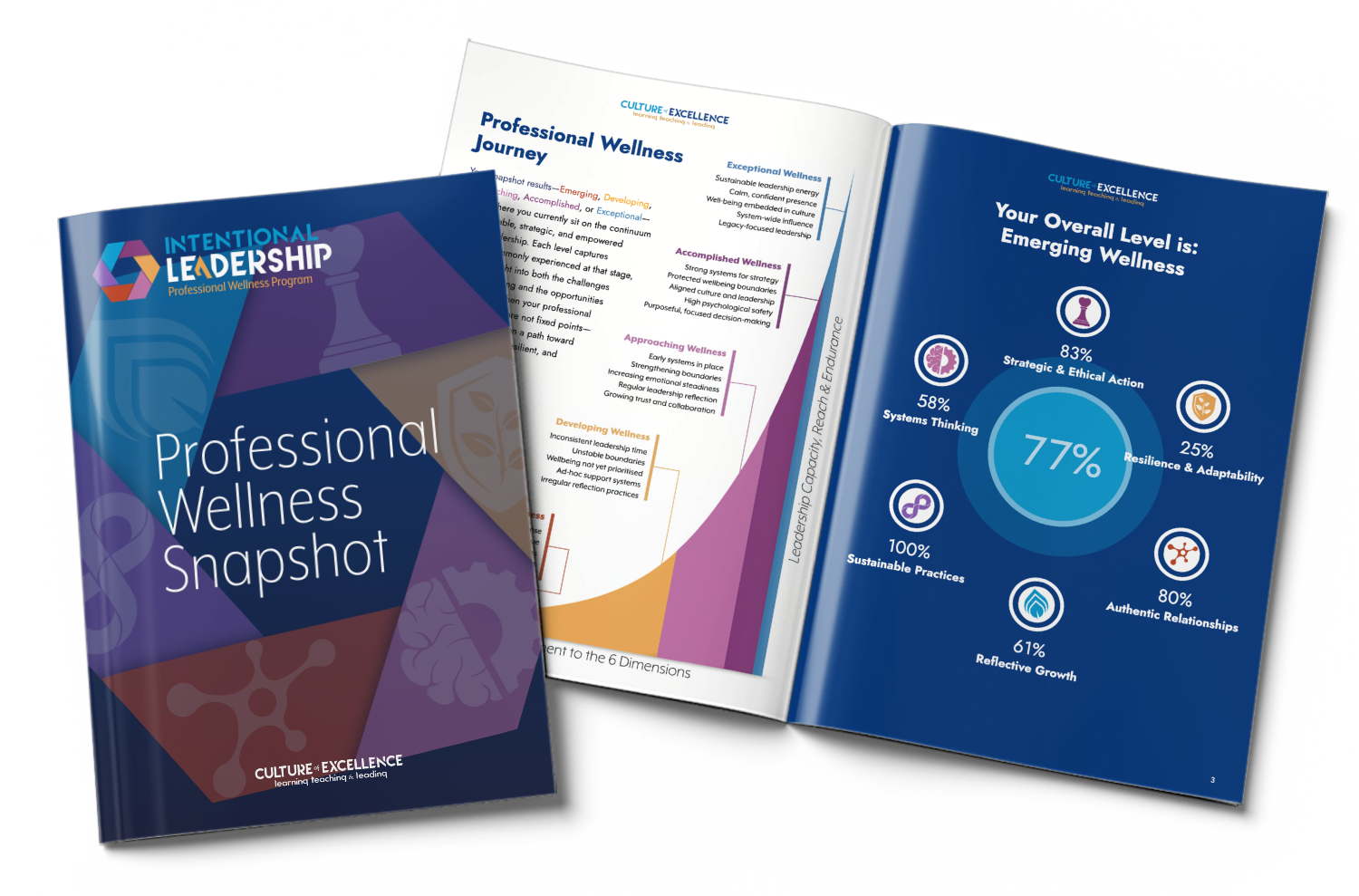
Directionless Decision-Making
When leadership decisions are happening without alignment or strategy
This video explores how the pressure to act, decide, and perform under constant demands leads many school leaders to mistake motion for progress. When clarity is missing, decisions become scattered. And without a shared direction, even good choices fragment energy instead of building momentum.
Where in your leadership are you making lots of decisions—but not sure if they’re actually moving the school forward?
Want to Lead With Steadiness—Not Strain?
Join our FREE Professional Wellness Workshop—a live session where we explore all six dimensions and help you refocus on what really sustains school leadership.

Directionless Decision-Making
When leadership decisions are happening without alignment or strategy
It’s one of the quietest frustrations in school leadership: “I’m making decisions all day… but I don’t know if they actually matter.”
Not because you don’t care, and not because you’re out of your depth. But because every time you try to lead strategically, something urgent knocks at the door. And slowly, the rhythm of your role changes.
You stop leading with intention—and start responding by default. The to-do list stays full, and the calendar is packed. But progress? That’s harder to measure.
You’re moving constantly—but not always forward.
When motion replaces momentum
Directionless decision-making happens when the appearance of productivity replaces strategic alignment. It’s not a leadership flaw; it’s a structural drift—a byproduct of urgency addiction, short-term pressures, and legacy systems that reward reactivity over reflection.
In one study of Australian school leaders, principals reported spending over 80% of their time on reactive operational tasks, with only 6% devoted to long-term planning or vision-setting (OECD, 2019). And that’s in systems that expect transformation—but don’t protect the time to lead it.
When this happens long enough, leadership decisions become scattered. Plans multiply, priorities compete, and the team starts to wonder: What are we actually trying to achieve?
This was the theme behind our recent carousel post on Directionless Decision-Making—and the conversation it sparked has been one of the most consistent inside the Professional Wellness Program.
Strategic leadership doesn’t mean doing more—it means being clearer about what matters most.
Drift doesn’t feel like failure—it feels like busyness
The reason this is so hard to spot is because it looks like you’re doing everything right. After all, you’re visible, you’re decisive, and you’re working hard. But in the absence of clear direction, all that energy gets distributed laterally. You’re stuck managing complexity rather than leading progress. And the hidden costs stack up:
- Your staff lose clarity on what matters most
- Decision fatigue sets in
- Your leadership confidence erodes quietly, day by day
As Michael Fullan notes, “The sheer volume of change can become the enemy of meaningful improvement.” Without a filter, even good ideas become distractions.
Strategic clarity is not a luxury—it’s a discipline
One of the most important shifts we help leaders make in the Professional Wellness Workshop is this: Strategic leadership doesn’t mean doing more—it means being clearer about what matters most. And that requires protecting a different kind of time:
Time to think. Time to align. Time to ask, why this—and why now?
In the video post on Directionless Decision-Making, I introduced a practical reset strategy:
- Take 15 minutes. Write down your top 3 school-wide priorities.
- Then ask: Are our daily actions aligned with these?
- If not—what are we spending energy on that doesn’t serve them?
This isn’t just a planning activity. It’s a leadership lens.
And using it consistently builds clarity into your decision-making—without needing another meeting or initiative.
Real leadership doesn’t come from speed—it comes from alignment
This idea echoes what we explored in Leadership in Triage and The Emotional Tsunami. When leaders are stuck in crisis or emotional reactivity, they lose access to the kind of slow thinking that enables long-term success.
Daniel Kahneman’s work on “System 1 vs. System 2” thinking explains why this matters: under pressure, we default to speed, instinct, and heuristics. But real strategy—the kind that creates cultural coherence—requires reflection, synthesis, and pause.
You can’t build a vision if you’re always putting out fires.
And you can’t ask your staff to align if your own leadership lens is foggy.
One aligned decision can shift a whole week
This isn’t about a complete overhaul.
It’s about creating small, consistent shifts that reinforce your direction—and protect your leadership energy.
- Say no to something that doesn’t fit your priorities
- Reconnect a team conversation to a shared goal
- Clarify one decision through your top-3 lens
- Protect a 15-minute window each week to realign
These micro-adjustments compound over time. And they shift your leadership from drift to design.
References
Fullan, M. (2001). Leading in a culture of change. San Francisco, CA: Jossey-Bass.
Kahneman, D. (2011). Thinking, fast and slow. New York: Farrar, Straus and Giroux.
Organisation for Economic Co-operation and Development (OECD). (2019). Education at a Glance 2019: OECD Indicators. OECD Publishing. https://doi.org/10.1787/f8d7880d-en

Not Sure What's Holding You Back?
Take our quick 2-minute Professional Wellness Snapshot to pinpoint where your biggest barrier lies—and which leadership dimension to strengthen next.